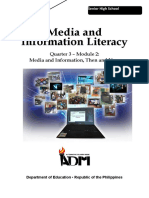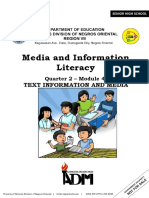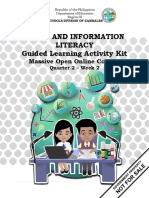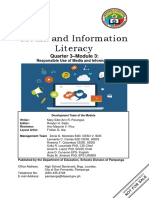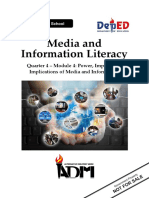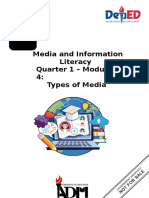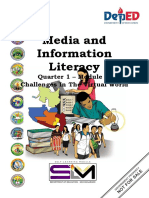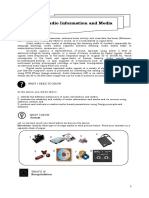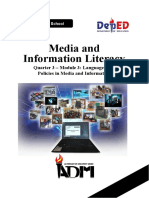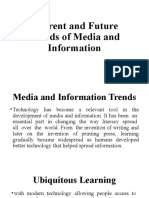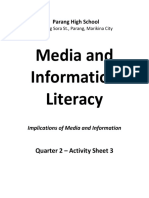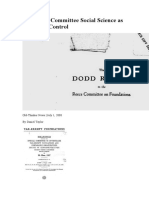EDUCATIONAL SYSTEMS
TECHNOLOGICAL INSTITUTE
Murallon, Boac, Marinduque
Media and Information
Literacy
Quarter 2 – Module 3 (W5 & W6)
Implications of Media and
Information
7
�What I Know
True or False: Write True if the statement is a fact; otherwise, write False.
_______ 1. The media force feeds information to unwilling receivers.
_______ 2. Media and Information literate individuals enjoy an improved quality of
life.
_______ 3. Media and information literate individuals actively participate in politics.
_______ 4. Only paid online content generates income.
_______ 5. IT based jobs are needed in the media.
_______ 6. Media and information have re-made the learning environment.
_______ 7. Media and information literate individuals are in total disconnected to the world.
_______ 8. Creation of jobs is the media’s role in the economy.
_______ 9. Critical thinking is a skill necessary to become a media and information literate
individual.
_______ 10. Communication between media and information literate individuals has become
more complicated.
Lesson
Implications of Media and
1 Information
In the previous lesson, we explored the current and future trends in media and
information. We also expounded the idea that everything is in constant change, and this
change is affected not just by media and information alone, but by how connected we are in
the wide global network.
Media and information literacy is a transformative factor to the person who
possesses it. This empowers people to be real agents of change in society. But then, can we
consider ourselves as media and information literate? This, we will find out as we probe the
identity of the media and information literate individual.
What’s In
In 2016, a Broadway stage musical made waves for tackling sensitive issues regarding
today’s generation, including social anxiety, depression and suicide. This is entitled “Dear
Evan Hansen” and tells the story of Evan, a teenager suffering social anxiety. You may view
an excerpt of this musical through this link.
https://www.youtube.com/watch?v=h9rf5wFq3zk
Here are the lyrics of the song “Waving Through a Window.” Take time to read it and think
about how a person can feel left out in a world when everybody is
practically connected by social media. -DearEvanposter.png
Waving Through a Window From “Dear Give them
Evan Hansen” no reason
I've learned to slam on the brake to stare
Before I even turn the key No slipping
Before I make the mistake up if you
Before I lead with the worst of me slip away
Retrieved from So I got
https://upload.wikimedia.org/ nothing to
wikipedia/e share No, I
n/thumb/9/91/DearEvanposte got nothing
r.png/220px to say
7
�Step out, step out of the sun What’s New
If you keep getting burned Waving through a window, oh Can anybody
Step out, step out of the sun Because see, is anybody waving?
you've learned, because you've learned When you're falling in a forest and there's
nobody around Do you ever really crash,
On the outside, always looking in Will I
or even make a sound?
ever be more than I've always been?
When you're falling in a forest and there's
'Cause I'm tap, tap, tapping on the glass nobody around Do you ever really crash,
I'm waving through a window or even make a sound?
I try to speak, but nobody can hear So I When you're falling in a forest and there's
wait around for an answer to appear nobody around Do you ever really crash,
While I'm watch, watch, watching or even make a sound?
people pass When you're falling in a forest and there's
I'm waving through a window, oh Can nobody around Do you ever really crash,
anybody see, is anybody waving back or even make a sound?
at me? Did I even make a sound?
We start with stars in our eyes Did I even make a sound? It's
We start believing that we belong like I never made a sound Will I
But every sun doesn't rise And no one ever make a sound?
tells you where you went wrong On the outside, always looking in Will I
Step out, step out of the sun ever be more than I've always been?
If you keep getting burned 'Cause I'm tap, tap, tapping on the glass
Step out, step out of the sun Because Waving through a window
you've learned, because you've learned I try to speak, but nobody can hear So I
wait around for an answer to appear
On the outside, always looking in Will I While I'm watch, watch, watching
ever be more than I've always been? people pass Waving through a window,
'Cause I'm tap, tap, tapping on the glass oh Can anybody see, is anybody
Waving through a window waving back at me? (oh)
I try to speak, but nobody can hear So I
wait around for an answer to appear Is anybody waving?
While I'm watch, watch, watching Waving, waving, whoa-oh, whoa-oh
people pass
It is natural for teenagers to be technology savvy, but elderlies tinkering millennial gadgets
is something unusual. Read these news articles about senior citizens engaged in digital
technology and answer the questions that follow.
1. 'Lola Techie' urges senior citizens to be IT savvy
Tam Noda (The Philippine Star) - June 27, 2013 - 12:56pm
MANILA, Philippines - Local television personality Tessie "Lola Techie" Moreno is urging
senior citizens to use information technology to spread their "elderly wisdom" especially
among the young.
The Information and Communications
Technology Office of the DOST (DOST-ICTO)
has tapped Moreno to give talks to senior
citizens in various barangays in Quezon City as
part of the celebration of the national ICT Month
2013 with the theme "Inclusive ICT for a
Smarter Philippines".
7
�As part of its program, the DOST-ICTO through the National Computer Institute (NCI) is
conducting basic computer literacy courses specifically designed for senior citizens. The
program is focused on communication tools particularly social media, such as Facebook,
Twitter, and Skype.
Moreno, a 71-year-old grandmother, known for her role as a computer-savvy lola in a
series of television commercials and viral
"Hipstamatic'12 - Gadgets" by
koalazymonkey is licensed under CC videos with local telecom operator Bayantel,
BY-ND 2.0 told the elderly on how they can improve their
lives using IT as she shared her real life
experiences in learning how to use technology, and how it has made her to be more
productive despite learning how to use it at an advanced age.
In her talk, Moreno said that there is a next generation of the elderly who are catching up in
the use of ICT.
"ICT can open up opportunities to enable us to use our collective elderly wisdom to
contribute once more to society," Moreno said. "Through ICT, we can warn the new
generation not to commit the same mistakes again as we did in our time, offer some
solutions by actually showing them how, through our loving example, and advocate for
reforms through social media, blogging and email campaigns."
For Lola Techie, the availability of "Skype" breaks the barrier of distance in talking
face-to-face with her children and grandchildren.
Yet Google helps her in doing important researches. While Facebook and other
social networking services like Twitter, Plurk and Multiply keep her connected with the digital
world.
According to DOST-ICTO Undersecretary Louis Napoleon Casambre, by
empowering the members of the society, ICT as a true enabler has given Filipinos the tools
to realize their dreams and has helped them achieve financial independence.
2. San Pablo City’s elderly trained on new tech gadgets
By Saul Pa-a September 4, 2018, 5:17 pm
SAN PABLO CITY, Laguna – In the run-up to the special day celebration for
Grandparents Day every second Sunday of September, a popular mall in this city is
organizing its gadget literacy tutorial through the annual “Oldies but Techies” program for the
elderly to keep them abreast with modern communication gadgets.
Evelyn Verzola, mall manager of SM City Pablo, told Philippine News Agency on
Tuesday that their tutorial program, which started in 2011 as “High Tech si Lolo at Lola Ko,”
is now dubbed “Oldies but Techies” to keep pace with the techie generation.
Verzola said the mall management has partnered with Power Mac in introducing and
guiding the senior citizens on the latest apps and social media platform.
“We really want to make our grandparents feel welcome here in SM from the
moment they enter our malls up until they leave, we want them to have memorable moments
with their family and peers,” said Nina Wong, the mall public relations manager.
Wong said the city mall here is undertaking the modern communication apps literacy
program for the elderly sector, which is implemented across all SM City supermalls
nationwide as part of the SM Cares programs for senior citizens in partnership with their mall
tenants.
“This techie learning program is only one of many services offered to the city’s senior
citizens besides granting them free movie passes and other social programs such as free
7
�medical checkups, free eyeglasses and special flowers for them as well as to the
marginalized and disadvantaged sectors,” she added.
The mall management said the techie learning sessions for the senior citizens are a
way to spend more time with their family and their fellow elders and in recognition of their
roles and contributions to society.
“They (senior citizens) deserve nothing less just as we honor mothers and fathers
with special days we also dedicate a special day for them to show our love and affection and
this “techie” activity would certainly thrill them,” a maller remarked.
Another shopper also said: “magandang program ito kasi, lalong na pag buo ang
pamilya sa mga techie communication gadgets ngayon tulad ng chats at mga posts at puede
sila mag-games para di mainip (this is a good program as this brings the family closer using
techie communication gadgets now like the chats and posts and they can also play games to
while away the time).”
A computer instructor also commented that teaching the elderly how to operate gadgets
bring them simple joys as they are delighted to tinker with the equipment they had not seen
or used during their time.
Guide questions:
1. What are the benefits senior citizens get in learning new technology?
2. What can the new generation learn from the elders who are techie savvy?
3. How do modern communication gadgets bridge the generation gaps within the
family?
What is It
A senior high school student might ask why Media and Information Literacy becomes
a core subject in the curriculum, while it could have been a specialized subject meant only
for students who are inclined for further academic studies in communication and media arts.
The reason is simple: every citizen must be media and information literate.
One of the proponents for this conclusion dates back to 2010, in the 3rd United Nations
Alliance of Civilizations (UNAOC) Global Forum on May 2010 in Rio de
Janeiro Brazil. In one of its thematic sessions focusing on the social impact of media
literacy, media literacy was identified as “an empowerment tool that facilitates the active
participation of citizens in the political process of contemporary societies.” MIL is considered
as a platform for social inclusion, especially in the new digital environment, where the youth
who are becoming more and more exposed to social media, are challenged to become
more involved participants in their communities. Moreover, the new digital environment
promotes a certain “participatory culture” that empowers individuals to get actively involved
in democratic societies, thus enabling them to participate in social discourse and deeper
dialogue with their communities.
Education is the key factor to inform societies about the implications of media and
information literacy. Thus, UNESCO’s Teacher Training Curricula for media and information
literacy was highlighted as the new resource that identifies the core competencies and areas
in general education associated with MIL. In 2010, discussions on MIL were not yet
highlighted in exiting curricula for general education around the world. Therefore, the need
educate people in this brand new perspective was seen as a much-needed course of action.
The end point of the 2010 Rio de Janeiro Forum was the identification of the attributes of
media and information literacy: a necessary source for social inclusion, and a platform that
facilitates the development of citizenship participation in pluralistic societies. All MIL
initiatives, whether within or beyond the formal education settings were regarded as key
elements for the promotion of intercultural dialogue.
What’s More
7
� Meant for a Better World
UNESCO refers to Media and Information Literacy as the essential competency and
skills that enables people to engage with media and other information providers effectively
and develop critical thinking and life-long learning skills to socialize and become active
citizens. Therefore, media and information literate individuals have improved the quality of
life, show active participation in politics, promote economic opportunities, enjoy an improved
learning environment and become a more cohesive social unit as an individual.
The following implications of media and information literacy is extracted from the
“E-Learning Guide on Media and Information Literacy” available in https://sites.google.com/.
Media and information improve quality of life
Anyone can attest that life before is different than life today. The dawn of every age in
history has always been brought by developments that change society’s way of life. From
the stone age ushered by cavemen who developed stones as tools, to today’s information
age brought about by media and information technologies, the change of era from then until
now is prompted by the desire to make things better.
There is no denying the extent of how the media and information age has drastically
improved the lives of people. Communication has been made easier. Information has
become widely accessible. Conducting research has become more convenient. There is
entertainment content for everyone. Things that used to take time to long distance
communication are now instantaneous. The cost of getting information is down from
exorbitant to incredibly cheap – often even free. What was one for the select few, are now
for everyone. All these and more are enjoyed by media literate individuals and prove just
how much the quality of life has improved thanks to media and information.
Media and information for greater political participation
The media and the government have a long-standing relationship in the field of public
service. While the government serves the people by leading the nation towards progress,
the media serve them by informing the public about subjects they need or want to know.
Politics is a persisting media content, particularly in news.
Former President Benigno Aquino III once alluded that the Filipino people are his
boss. Unlike bosses, however, not everyone has the time or resources to verify if those in
the government serve the best interest of the Filipino people as a whole. So the media does
this job for them. It is said that the media serves as the eyes and the ears of the masses in
the government. Through media reports of government activities and issues, the publics are
informed of the political affairs in the country and are further encouraged to take a more
active role in the government.
Media and information promoting economic opportunities
The media industry has grown in number in today’s information age both in content and in
the workforce. The open content contribution nature of the new media has made it possible
for ordinary individuals to offer their materials for consumption often for free or at times for a
cost. Typically, if online content is free but has gained popularity, advertisers will offer to buy
digital ad space on a web page. Even YouTube, a free video host, pays video contributors if
their videos get enough views or if their channels have a high subscriber rate. Paid content,
on the other hand, creates direct revenue. Free or not, media and information give
contributors a platform for earning additional income.
It is true that the influx of media offerings has led to the creation of more jobs in the media.
Of course, if there is an increase in content, there’s a need for more people to manage them.
The convergence of various media platforms has created hybrid mediums that requires
experts to run them. The persistent need to always be in the know has called for specialists
to maintain the ubiquitous nature of media and information. New jobs like social media
managers or multimedia specialists have been created because of this growth. Even IT
based jobs which were once rarities in the media are now a necessity. As media and
information grow, so does jobs that require media and information literate individuals and
7
�when jobs grow, so does the economy. Employment or the lack thereof persists as an
economic problem in most developing countries like the Philippines. The media industry in
the age of information plays a vital catalyst role to address that.
Media and information for improvement of learning environment
Many believe that media and information have made learning easy, accessible and
inexpensive. Which these are true, the improvement in the learning environment brought by
media and information goes beyond convenience, availability and cost. Its true implication is
that it made the learning an object of desire. For so long, the concept of learning has been a
sores subject for many. This is not because everyone is just innately opposed to learning -in
fact, the birth of the information age proves the exact opposite- but because the learning
environment people were exposed to is simply unattractive. For so long learning has been
perceived as a tedious yet necessary part of everyone/s lives. Learning is schools meant
understanding – or at least attempting to- subjects for the sake of passing or getting good
grades. One’s education is given importance because it is pre-requisite to a good which is
then equated to a good life. Traditional learning environments have caused people in
general to lose appetite for knowledge. Luckily, media and information have cleansed
society’s palate and have reinvented learning.
Media does not force feed information to unwilling receivers; instead, media has made
information sought after. By offering a wide variety of content through various platforms,
there is information that would appeal to everyone. The media also made learning a choice
instead of a necessary evil. After all, no one is commanded “google” a topic or enroll on a
certain online course, people who do so chose to do it. Since the media is a source of
information and information age is characterized by the abundance of data, media and
information have been closely linked to the improvement of the learning environment in the
present age. A media and information literate individual take advantage of this to further his
or her lifelong learning process.
Media and Information individuals as more cohesive social units
The concept of unit cohesion stems from a military concept of the bond soldiers have that
makes them more effective in working together to complete a mission. Media and
information literate individuals are said to be more cohesive social units than those who are
not. By keeping them informed, as well as connecting them in ways that were not possible
before, media and information literates becomes more cohesive social units. This creates a
bond that does not only have relational implications but also creates societal impacts.
The media is said to have the power to affect social change. While this is true, it is not the
media that does the heavy lifting to create change in society, it is the individuals in the
society who developed a clamoring need for change because of media. The media and
information literate individuals sharing that same goal, development would not occur.
What I Have Learned
One of the most iconic songs made for a movie is Justin Paul and Benj Pasek’s “This Is Me”
from the movie “The Greatest Showman” (2017). This has become an anthem during the
time when diversity was the demand in many social institutions. Read the lyrics of the song.
You may even sing along with a lyric video via YouTube, then answer the questions that
follow:
Guide Questions:
1. “This Is Me” is a musical interpretation of the cries of the marginalized,
disenfranchised, the bullied and the outcast. Do you believe that this song does its
work to promote social inclusion?
2. Search various interpretations of this song through different platforms. Which
members of society are represented in the videos? If you do not have internet
access, observe the picture of the cast of “The Greatest Showman” below and use it
to help you answer this question.
3. Cite other media and information utilized to foster social inclusion in a pluralistic
society.
7
�"Our dancer loves The Greatest Showman" by Bernie Goldbach is licensed under CC BY-
NC-ND 2.0
THIS IS ME
For we are glorious When the sharpest
I am not a stranger to the dark words wanna cut me down
Hide away, they say I'm gonna send a flood, gonna drown 'em out
'Cause we don't want your broken parts I am brave, I am bruised
I've learned to be ashamed of all my scars I am who I'm meant to be, this is me
Run away, they say Look out 'cause here I come
No one'll love you as you are But I won't And I'm marching on to the beat I drum
let them break me down to dust I'm not scared to be seen
I know that there's a place for us I make no apologies, this is me
For we are glorious Oh-oh-oh-oh…
When the sharpest words wanna cut me This is me
down And I know that I deserve your love
I'm gonna send a flood, gonna drown 'em out There's nothing I'm not worthy of When the
I am brave, I am bruised sharpest words wanna cut me down
I am who I'm meant to be, this is me I'm gonna send a flood, gonna drown 'em out
Look out 'cause here I come This is brave, this is bruised
And I'm marching on to the beat I drum This is who I'm meant to be, this is me
I'm not scared to be seen Look out 'cause here I come
I make no apologies, this is me And I'm marching on to the beat I drum
Oh-oh-oh-oh… I'm not scared to be seen
Another round of bullets hits my skin Well, I make no apologies, this is me.
fire away 'cause today, I won't let the
shame sink in
We are bursting through the barricades and
Reaching for the sun (we are warriors) Yeah,
that's what we've become
I won't let them break me down to dust
I know that there's a place for us
7
�What I Can Do
Let’s Compare Notes
Let us look into how the implications of media and information are reflected
in actual situations. Since I am a GenXer (a 1990’s youth) and you belong to
Generation Z (anyone born from 1997 onward, according to Dimock [2019]) let’s try
to compare notes. I’ll tell you accounts during my youth when media and information
educated me, and tell me yours based on the latest trends and news.
Implications of Media and GEN X Speaks GEN Z Speaks
Information (My Space) (Your Space)
improves In the 1980’s and 1990’s I enjoyed
quality of life viewing commercials about
innovative consumer products.
Some TV shows would also
include segments for indorsement
of these products.
These products include
toothpaste the came on soft
plastic tubes, calamansiinfused
laundry soap, and my all-time
favorite comfort food, instant
pancit canton.
promotes greater political On February 1986, Jaime
participation Cardinal Sin, then archbishop of
Manila, urged Filipinos through
radio to gather in EDSA in a move
to oust the dictator. That began
the People Power Revolution,
known all over the world as the
“first bloodless revolution in
history.”
provides economic Some TV shows were aired in
opportunities order to help televiewers acquire
skills for business. Some of these
are “Tele-Aralan ng Kakayahan”
(Channel 4) and “Negosiyete”
(Channel 7). My fondness for
handicrafts is influenced by these
shows.
improves learning TV and komiks were my first non-
environment human teachers. The TV show
“Sesame Street” taught me
English and a bit of Spanish, while
“Kulit Bulilit” and “Batibot”
exposed me to various Filipino
cultures. “Funny Comics,” on the
other hand, taught me how to
read. All these I learned even
before I entered formal schooling.
hones individuals In 1994, we staged a play for the
people of Canlubang, our
� as more cohesive social barangay which, at that time, was
units about to undergo a drastic
change. Our stage play served as
a celebration of our community’s
glorious past and preparation to
what would happen next – the
closure of the sugar industry and
relocation of residents to name
some.
Assessment
Here are 8 visual contents from the internet. Identify their implications to an
individual or society. Choose from the following:
A. improves quality of life
B. promotes greater political participation
C. provides economic opportunities
D. improves learning environment
E. hones individuals as more cohesive social units
Afterwards, support your choice using one or two sentences per content.
�Additional Activities
Reflection
Is the song “This Is Me” still ringing in your ears? I hope you can share a bit of your
story and tell how media and information change the way you look at yourself and
how you see other people. A short 100-word essay will mean a lot.
Credits to: Department of Education

